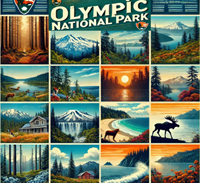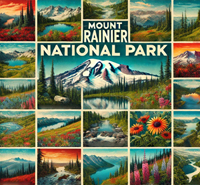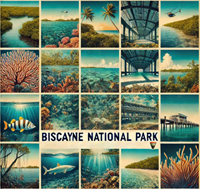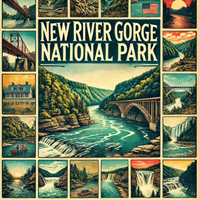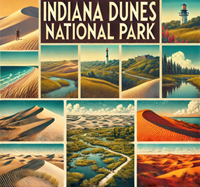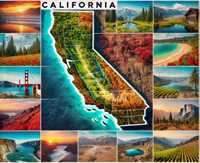
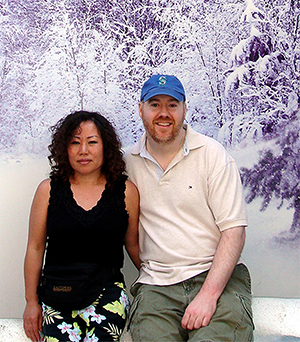
Embark on a journey curated by seasoned explorers William and Hui Cha Stanek, who have spent decades immersing themselves in the diverse landscapes of North America. These itineraries are more than just travel plans - they are thoughtfully crafted adventures designed to help you connect with the natural world, discover hidden gems, and create lasting memories.
National Parks Index | US Itineraries Index | American Roadtrips Index

Bring home a Bugville Critters book and watch as your child's love for reading and learning grows with every page. Hand-painted illustrations bring the heartwarming stories to life. Ask your librarian to add Bugville Critters to the library's digital collection today!
Discover William Stanek's Exclusive Art Collection
Explore and purchase the stunning art featured on this site. Own a piece of William Stanek's unique and captivating artwork today!
(May 2, 2025) Exploring Lassen Volcanic National Park and Lava Beds National Monument: California's Volcanic Wonderland
Introduction: A 2-Day Journey into the Fiery Heart of Northern California
Northern California's volcanic landscape is a place where the earth's ancient forces are still at work, shaping the land and offering a glimpse into the dynamic processes that have created some of the most dramatic scenery in the state. For Hui Cha and me, exploring Lassen Volcanic National Park and Lava Beds National Monument is like stepping into a living geology textbook, where steaming fumaroles, bubbling mud pots, and lava tubes offer tangible evidence of the powerful forces that lie beneath the earth's surface.
Our adventure began with an early morning drive through the pine forests and meadows that surround Lassen Peak, the southernmost active volcano in the Cascade Range. Lassen Volcanic National Park is a place of contrasts, where towering peaks give way to lush meadows, and serene alpine lakes sit beside boiling springs and fumaroles. This park is a testament to the power of nature, with a landscape that has been shaped by volcanic activity over thousands of years.
A few hours to the north, Lava Beds National Monument offers a completely different experience. Here, the landscape is dotted with more than 800 caves and lava tubes, the result of ancient volcanic eruptions that have created a subterranean world waiting to be explored. The monument is also steeped in history, with evidence of the Modoc people's presence dating back thousands of years, and remnants of the Modoc War of the 1870s still visible in the rugged terrain.
Join us as we take you on a journey through these two incredible parks. We'll share our stories, tips, and insights to help you create your own unforgettable experiences in California's volcanic wonderland.
Day 1: The Volcanic Wonders of Lassen Volcanic National Park
Morning: Sunrise at Manzanita Lake
Overview
Start your Lassen adventure with a sunrise at Manzanita Lake, one of the most picturesque spots in the park. This serene alpine lake offers stunning views of Lassen Peak reflected in the water, making it a perfect spot to begin your day.
Tips from William
"Arrive at Manzanita Lake by 6:00 AM to catch the first light of day. The early morning light is perfect for photography, casting a warm glow over the lake and Lassen Peak. Bring a wide-angle lens to capture the full scene, and a polarizing filter to enhance the colors of the sky and the water. If you're lucky, you might even catch some mist rising off the lake, adding a magical touch to your photos."
Insights from Hui Cha
"Manzanita Lake at sunrise is a place of peace and beauty. The stillness of the water, the reflection of the peak, and the cool morning air create a sense of tranquility that stays with you throughout the day. Dress warmly, as it can be chilly in the early morning, and bring a blanket to sit on while you enjoy the view."
How to Access Manzanita Lake
Directions:
- From the Lassen Volcanic National Park entrance, take Lassen Park Road south for about 2 miles to the Manzanita Lake parking area.
Viewpoint Details:
- Location: About 2 miles south of the park entrance
- Elevation Gain: None
- Difficulty: Easy
Photography Tips: For the best shots of Manzanita Lake, position yourself on the eastern shore to capture the first light as it hits Lassen Peak. Use a small aperture (f/16 or smaller) to keep both the foreground and the distant peak in focus. A wide-angle lens will allow you to capture the full scope of the scene, and a tripod is essential for stabilizing your camera in the low light.
Alternative Activity: If the early morning start at Manzanita Lake is too demanding, consider watching the sunrise from the nearby Reflection Lake, which offers equally stunning views of Lassen Peak and the surrounding forest.
Mid-Morning: Hiking the Bumpass Hell Trail
Overview
After enjoying the peaceful beauty of Manzanita Lake, embark on one of Lassen's most famous hikes – the Bumpass Hell Trail. This moderate hike takes you to the park's largest hydrothermal area, where you can see boiling springs, steaming fumaroles, and colorful hot springs.
Tips from William
"The Bumpass Hell Trail is a must-do hike in Lassen, offering some of the most unique and colorful landscapes in the park. Bring a wide-angle lens to capture the expansive views of the hydrothermal area, but also keep a telephoto lens handy for zooming in on the details of the boiling springs and fumaroles. The trail is moderately challenging, so be sure to bring plenty of water and wear sturdy hiking boots."
Insights from Hui Cha
"This hike is one of my favorites in Lassen. The sight of the bubbling springs, the smell of sulfur in the air, and the colorful deposits around the fumaroles make this a perfect way to experience the volcanic activity that shaped this landscape. Take your time on the trail, and don't forget to stop and enjoy the views along the way."
How to Access the Bumpass Hell Trail
Directions:
- From Manzanita Lake, take Lassen Park Road south for about 17 miles to the Bumpass Hell parking area.
Trail Details:
- Trail Length: 3 miles round-trip
- Elevation Gain: 300 feet
- Difficulty: Moderate
Photography Tips: For the best shots of Bumpass Hell, arrive mid-morning to catch the soft light as it illuminates the hydrothermal area. Use a wide-angle lens to capture the full scope of the landscape, and experiment with different compositions to highlight the contrast between the boiling springs and the surrounding mountains. For a more creative shot, try using a telephoto lens to focus on the details of the fumaroles and the colorful mineral deposits.
Alternative Activity: If the hike to Bumpass Hell is too challenging, consider exploring the shorter Devastated Area Interpretive Trail, a 0.5-mile loop that offers beautiful views of the park's volcanic features and the surrounding forest.
Afternoon: Exploring Lassen Peak
Overview
In the afternoon, take on one of Lassen's most iconic hikes – Lassen Peak. This challenging hike takes you to the summit of the park's namesake volcano, offering panoramic views of the surrounding landscape and a close-up look at the volcanic forces that shaped this region.
Tips from William
"Hiking Lassen Peak is a challenging but rewarding experience, offering some of the best views in the park. Bring a wide-angle lens to capture the expansive vistas from the summit, but also keep a telephoto lens handy for zooming in on the details of the volcanic landscape. The trail is steep and strenuous, so be sure to bring plenty of water, snacks, and layers for the changing weather conditions."
Insights from Hui Cha
"Reaching the summit of Lassen Peak is an accomplishment you won't soon forget. The views from the top are absolutely breathtaking, with the entire park spread out below you and the distant peaks of the Sierra Nevada visible on the horizon. Take your time on the trail, and don't forget to stop and enjoy the views along the way."
How to Access the Lassen Peak Trail
Directions:
- From the Bumpass Hell parking area, continue south on Lassen Park Road for about 3 miles to the Lassen Peak parking area.
Trail Details:
- Trail Length: 5 miles round-trip
- Elevation Gain: 2,000 feet
- Difficulty: Strenuous
Photography Tips: For the best shots from the summit of Lassen Peak, arrive in the afternoon to catch the soft light as it illuminates the surrounding landscape. Use a wide-angle lens to capture the full scope of the views, and experiment with different compositions to highlight the contrast between the volcanic features and the distant peaks. For a more creative shot, try using a telephoto lens to focus on the details of the rock formations and the surrounding mountains.
Alternative Activity: If the hike to Lassen Peak is too challenging or long, consider exploring the shorter but equally rewarding trail to Ridge Lakes. This 2-mile round-trip hike offers stunning views of the surrounding peaks and a peaceful alpine lake.
Evening: Sunset at Chaos Crags
Overview
End your day with a visit to Chaos Crags, one of the most dramatic and geologically interesting areas in Lassen Volcanic National Park. These jagged lava domes were formed by a series of volcanic eruptions over the past 1,100 years, and the views from the base are spectacular.
Tips from William
"Chaos Crags is a fantastic spot to capture the sunset, with wide, sweeping views of the surrounding landscape and the rugged lava domes. Set up your tripod well before sunset to find the best angle, and use a wide-angle lens to capture the full scene. A graduated neutral density filter will help balance the exposure between the bright sky and the darker landscape."
Insights from Hui Cha
"Sunset at Chaos Crags is one of the most beautiful experiences you can have in Lassen. The way the light plays across the rugged lava domes, casting long shadows and turning the rock a deep red, is truly magical. Bring a blanket and a warm drink, and take some time to simply sit and enjoy the moment."
How to Access Chaos Crags
Directions:
- From the Lassen Peak parking area, drive north on Lassen Park Road for about 8 miles to the Chaos Crags parking area.
Viewpoint Details:
- Location: About 8 miles north of Lassen Peak on Lassen Park Road
- Elevation Gain: None
- Difficulty: Easy
Photography Tips: For a stunning sunset shot, position yourself on the western side of the viewpoint to capture the last light of the day as it illuminates the lava domes. Use a small aperture (f/16 or smaller) to keep the entire scene in focus, and experiment with different shutter speeds to capture the changing light. If the conditions are right, consider staying after sunset to photograph the stars as they appear.
Alternative Activity: If you prefer a less crowded spot for sunset, consider visiting the nearby Summit Lake, which offers equally stunning views of the surrounding mountains and a peaceful lakeside setting.
Conclusion: Reflections on the Day
As the last rays of sunlight faded from the sky and the stars began to emerge, Hui Cha and I stood quietly at Chaos Crags, reflecting on the incredible journey we had just experienced. From the serene beauty of Manzanita Lake to the rugged grandeur of Lassen Peak, each moment had been a reminder of the sheer power and beauty of Lassen Volcanic National Park.
These moments, spent in the heart of nature, are what make our travels so meaningful. They're a reminder of the importance of preserving these wild places, and of the deep connection we feel to the land. As we packed up our gear and prepared to head back to our campsite, I felt a deep sense of gratitude for the day's experiences and for the time spent in this incredible park.
Our journey through California's volcanic wonderland was far from over. Tomorrow would take us to Lava Beds National Monument, where we would explore a subterranean world of lava tubes and caves. But for now, we were content to sit beneath the stars, listening to the quiet of the mountains and feeling the peace that only comes from being in the heart of the wilderness.
Day 2: The Subterranean World of Lava Beds National Monument
Morning: Sunrise at Petroglyph Point
Overview
Begin your day in Lava Beds National Monument with a sunrise visit to Petroglyph Point, one of the most culturally significant sites in the park. This ancient lava flow features more than 5,000 petroglyphs carved by the Modoc people, offering a glimpse into the history and culture of the region.
Tips from William
"Arrive at Petroglyph Point by 6:00 AM to catch the first light of day. The early morning light is perfect for photography, casting a warm glow over the petroglyphs and highlighting the textures and details of the carvings. Bring a wide-angle lens to capture the full scene, and a polarizing filter to enhance the colors of the sky and the rock."
Insights from Hui Cha
"Petroglyph Point at sunrise is a place of peace and reflection. The ancient carvings, the quiet of the morning, and the beauty of the landscape create a sense of connection to the past that is both humbling and inspiring. Dress warmly, as it can be cool in the early morning, and bring a blanket to sit on while you explore the area."
How to Access Petroglyph Point
Directions:
- From the Lava Beds Visitor Center, take the main park road south for about 5 miles to the Petroglyph Point parking area.
Viewpoint Details:
- Location: About 5 miles south of the Visitor Center
- Elevation Gain: None
- Difficulty: Easy
Photography Tips: For the best shots of Petroglyph Point, position yourself on the eastern side to capture the first light as it hits the carvings. Use a small aperture (f/16 or smaller) to keep both the foreground and the distant landscape in focus. A wide-angle lens will allow you to capture the full scope of the scene, and a tripod is essential for stabilizing your camera in the low light.
Alternative Activity: If the early morning start at Petroglyph Point is too demanding, consider watching the sunrise from the nearby Tule Lake National Wildlife Refuge, which offers beautiful views of the surrounding landscape and opportunities for birdwatching.
Mid-Morning: Exploring the Lava Tubes
Overview
After exploring Petroglyph Point, dive into the subterranean world of Lava Beds National Monument by exploring some of the park's famous lava tubes. These caves, formed by ancient volcanic eruptions, offer a unique and adventurous experience, with opportunities to see stalactites, lava flows, and other fascinating geological features.
Tips from William
"Exploring the lava tubes is a must-do activity in Lava Beds, offering a unique and exciting way to experience the park's volcanic landscape. Bring a headlamp or flashlight to light your way, and a wide-angle lens to capture the full scope of the caves. Be sure to wear sturdy shoes and a helmet, as the caves can be dark and rocky."
Insights from Hui Cha
"Walking through the lava tubes feels like stepping into another world. The cool air, the darkness, and the strange shapes of the rock create a sense of adventure that's hard to find anywhere else. Take your time as you explore the caves, and don't forget to look up – some of the most incredible formations are on the ceilings of the tubes."
How to Access the Lava Tubes
Directions:
- From Petroglyph Point, drive back to the Visitor Center and take the main park road north for about 2 miles to the Cave Loop Road. The parking areas for the lava tubes are located along this loop.
Cave Details:
- Total Length: Varies by cave (most are short walks)
- Elevation Gain: Minimal
- Difficulty: Easy to Moderate
Photography Tips: For the best shots inside the lava tubes, use a tripod to stabilize your camera in the low light, and experiment with different exposures to capture the details of the rock formations. A wide-angle lens will allow you to capture the full scope of the caves, and a headlamp with a red filter can help preserve your night vision while you shoot.
Alternative Activity: If you prefer to stay above ground, consider exploring the Captain Jack's Stronghold, a historic site where the Modoc people made their last stand during the Modoc War of 1872-73. The trail through the stronghold offers beautiful views of the surrounding landscape and opportunities to learn about the history of the region.
Afternoon: Hiking the Schonchin Butte Trail
Overview
In the afternoon, hike to the top of Schonchin Butte, an ancient cinder cone that offers panoramic views of the surrounding landscape and a close-up look at the volcanic features of Lava Beds National Monument. This moderate hike is a great way to experience the park's unique geology and enjoy the beauty of the high desert.
Tips from William
"The hike to Schonchin Butte is a great way to experience the volcanic landscape of Lava Beds from above. Bring a wide-angle lens to capture the expansive views from the summit, but also keep a telephoto lens handy for zooming in on the details of the lava flows and the surrounding mountains. The trail is moderately challenging, so be sure to bring plenty of water and wear sturdy hiking boots."
Insights from Hui Cha
"Reaching the summit of Schonchin Butte is a rewarding experience, with 360-degree views of the park and the distant peaks of the Cascade Range. The sense of isolation and the beauty of the landscape make this a perfect place to sit and reflect on the day's adventures."
How to Access the Schonchin Butte Trail
Directions:
- From the Cave Loop Road, continue north on the main park road for about 4 miles to the Schonchin Butte parking area.
Trail Details:
- Trail Length: 2 miles round-trip
- Elevation Gain: 500 feet
- Difficulty: Moderate
Photography Tips: For the best shots from the summit of Schonchin Butte, arrive in the afternoon to catch the soft light as it illuminates the surrounding landscape. Use a wide-angle lens to capture the full scope of the views, and experiment with different compositions to highlight the contrast between the volcanic features and the distant peaks. For a more creative shot, try using a telephoto lens to focus on the details of the cinder cone and the surrounding lava fields.
Alternative Activity: If the hike to Schonchin Butte is too challenging, consider exploring the shorter but equally scenic Fleener Chimneys Trail. This 1-mile round-trip hike takes you to a series of volcanic vents that offer a fascinating glimpse into the park's geothermal activity.
Evening: Sunset at Medicine Lake Volcano
Overview
End your day with a visit to Medicine Lake Volcano, a massive shield volcano that forms the northern boundary of Lava Beds National Monument. This remote and lesser-visited area offers stunning views of the surrounding landscape, with the opportunity to see unique volcanic features such as pumice fields, lava flows, and cinder cones.
Tips from William
"Medicine Lake Volcano is a fantastic spot to capture the sunset, with wide, sweeping views of the surrounding landscape and the distant peaks of the Cascades. Set up your tripod well before sunset to find the best angle, and use a wide-angle lens to capture the full scene. A graduated neutral density filter will help balance the exposure between the bright sky and the darker landscape."
Insights from Hui Cha
"Sunset at Medicine Lake Volcano is one of the most beautiful experiences you can have in Lava Beds. The way the light plays across the lava fields and the distant mountains, casting long shadows and turning the rock a deep red, is truly magical. Bring a blanket and a warm drink, and take some time to simply sit and enjoy the moment."
How to Access Medicine Lake Volcano
Directions:
- From Schonchin Butte, drive north on the main park road for about 10 miles to the Medicine Lake area. The parking areas for the volcano's viewpoints are located along this road.
Viewpoint Details:
- Location: About 10 miles north of Schonchin Butte on the main park road
- Elevation Gain: None (viewpoint is accessible by car)
- Difficulty: Easy
Photography Tips: For a stunning sunset shot, position yourself on the western side of the viewpoint to capture the last light of the day as it illuminates the lava fields and the distant peaks. Use a small aperture (f/16 or smaller) to keep the entire scene in focus, and experiment with different shutter speeds to capture the changing light. If the conditions are right, consider staying after sunset to photograph the stars as they appear.
Alternative Activity: If you prefer a less remote spot for sunset, consider visiting the nearby Heppe Ice Cave, a short walk from the road that offers fascinating views of an underground ice cave and opportunities for unique photography.
Conclusion: A Personal Reflection
As the last rays of sunlight faded from the sky and the stars began to emerge, Hui Cha and I stood quietly at Medicine Lake Volcano, reflecting on the incredible journey we had just experienced. From the ancient petroglyphs of Petroglyph Point to the subterranean wonders of the lava tubes, each moment had been a reminder of the sheer power and beauty of Lava Beds National Monument.
These parks are more than just places to visit – they are places to connect with the natural world, to find peace and inspiration, and to create memories that will last a lifetime. As we packed up our gear and prepared to head back to our campsite, I felt a deep sense of gratitude for the time we had spent in these wild, untamed places. They had not only shown us the beauty of the land but had also brought us closer to each other and to the world around us.
Our journey through California's volcanic wonderland had come to an end, but the experiences we had shared would stay with us forever. And as we drove away from the lava fields, I knew that we would return, drawn back by the promise of new adventures and the chance to explore even deeper into the heart of this fascinating and ever-changing landscape.

Step into a world of timeless beauty with our premium, oversized hardcover book - crafted for discerning collectors and anyone who values the power of art. Perfect for your coffee table, it's more than just a book; it's a conversation starter, a window into over 30 years of William's visionary photography.
Your Support Matters
Purchasing artwork from William Stanek's collection not only brings beauty into your life but also helps us continue to share. Thank you for supporting our creative journey!

Support The Lights of Paris by Robert Stanek, William Stanek's pen name! Through vivid historical detail and deeply moving character stories, Robert takes readers on an unforgettable journey through one of history’s most transformative times.


